Australia's Confectionary Market Analysis: MKT1MDP Report
VerifiedAdded on 2022/10/19
|7
|1839
|440
Report
AI Summary
This report provides a detailed analysis of the Australian confectionary industry. It begins with an introduction to the industry, highlighting its position as a non-luxury but not essential good, and the focus on chocolate and confectionery items. The report utilizes data from Marketline Advantage and IBISWorld, examining the industry's market segmentation, with a significant portion dedicated to chocolate. Key players like Mondelez International are identified, and macro-environmental factors (political, economic, social, technological, environmental, and legal) are assessed for their impact on the industry. Market segmentation is explored, including the dominance of chocolate and sugar segments, key brands, and distribution channels like supermarkets and convenience stores. The report also delves into market competition using Porter’s Five Forces analysis. Finally, it concludes with recommendations, noting the shift towards health-conscious consumers and the potential for innovation in sugar-free products, and referencing various research papers.
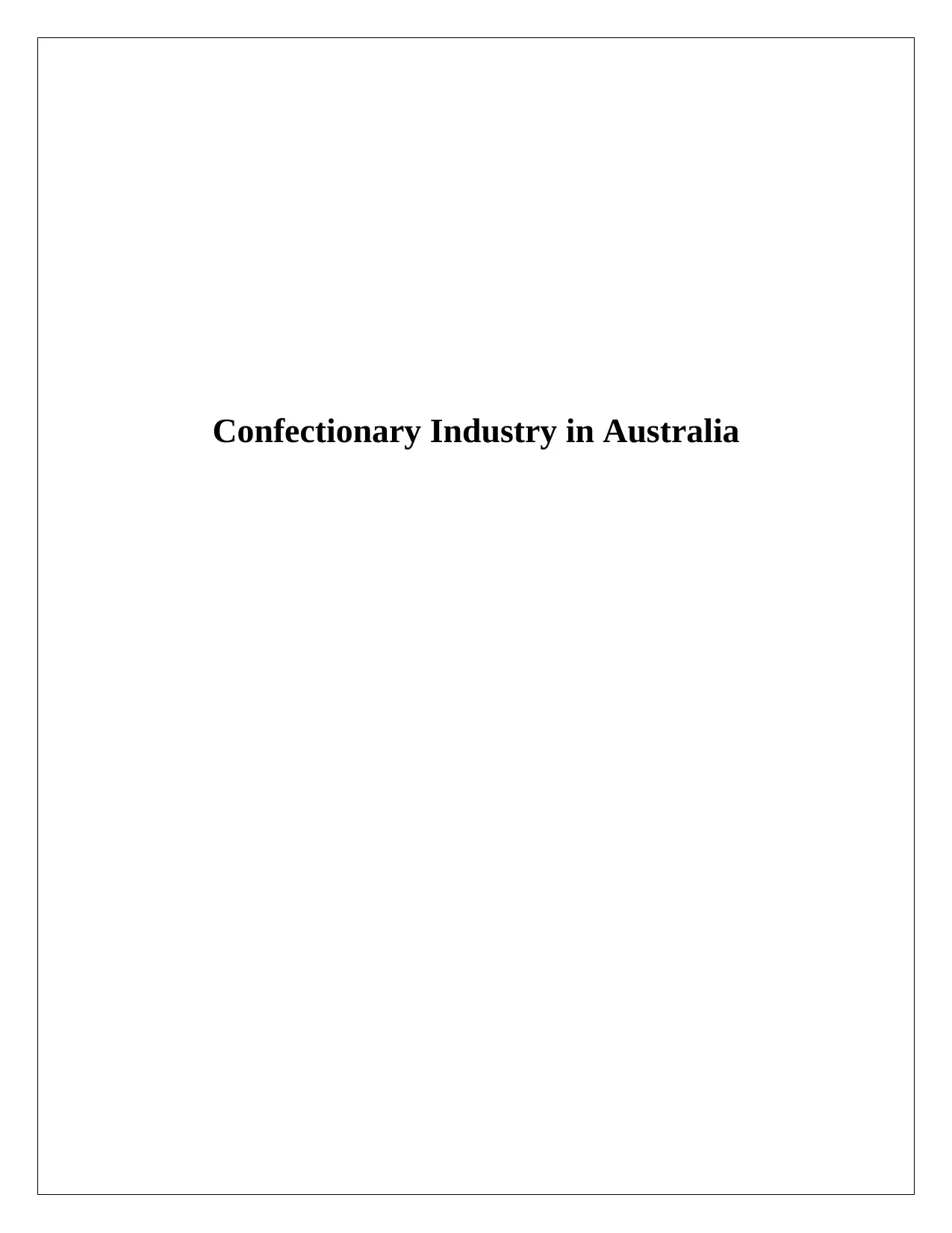
Confectionary Industry in Australia
Paraphrase This Document
Need a fresh take? Get an instant paraphrase of this document with our AI Paraphraser
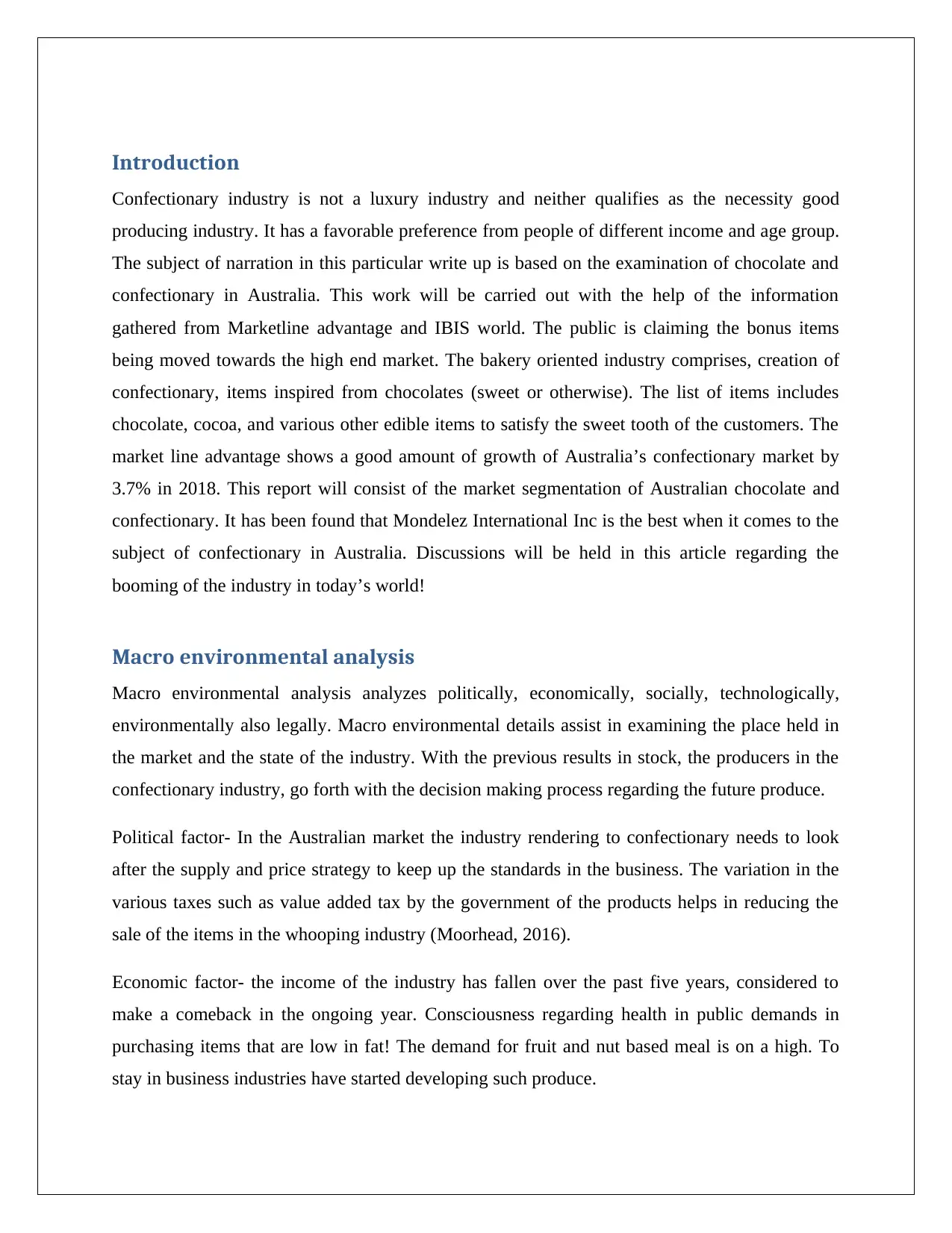
Introduction
Confectionary industry is not a luxury industry and neither qualifies as the necessity good
producing industry. It has a favorable preference from people of different income and age group.
The subject of narration in this particular write up is based on the examination of chocolate and
confectionary in Australia. This work will be carried out with the help of the information
gathered from Marketline advantage and IBIS world. The public is claiming the bonus items
being moved towards the high end market. The bakery oriented industry comprises, creation of
confectionary, items inspired from chocolates (sweet or otherwise). The list of items includes
chocolate, cocoa, and various other edible items to satisfy the sweet tooth of the customers. The
market line advantage shows a good amount of growth of Australia’s confectionary market by
3.7% in 2018. This report will consist of the market segmentation of Australian chocolate and
confectionary. It has been found that Mondelez International Inc is the best when it comes to the
subject of confectionary in Australia. Discussions will be held in this article regarding the
booming of the industry in today’s world!
Macro environmental analysis
Macro environmental analysis analyzes politically, economically, socially, technologically,
environmentally also legally. Macro environmental details assist in examining the place held in
the market and the state of the industry. With the previous results in stock, the producers in the
confectionary industry, go forth with the decision making process regarding the future produce.
Political factor- In the Australian market the industry rendering to confectionary needs to look
after the supply and price strategy to keep up the standards in the business. The variation in the
various taxes such as value added tax by the government of the products helps in reducing the
sale of the items in the whooping industry (Moorhead, 2016).
Economic factor- the income of the industry has fallen over the past five years, considered to
make a comeback in the ongoing year. Consciousness regarding health in public demands in
purchasing items that are low in fat! The demand for fruit and nut based meal is on a high. To
stay in business industries have started developing such produce.
Confectionary industry is not a luxury industry and neither qualifies as the necessity good
producing industry. It has a favorable preference from people of different income and age group.
The subject of narration in this particular write up is based on the examination of chocolate and
confectionary in Australia. This work will be carried out with the help of the information
gathered from Marketline advantage and IBIS world. The public is claiming the bonus items
being moved towards the high end market. The bakery oriented industry comprises, creation of
confectionary, items inspired from chocolates (sweet or otherwise). The list of items includes
chocolate, cocoa, and various other edible items to satisfy the sweet tooth of the customers. The
market line advantage shows a good amount of growth of Australia’s confectionary market by
3.7% in 2018. This report will consist of the market segmentation of Australian chocolate and
confectionary. It has been found that Mondelez International Inc is the best when it comes to the
subject of confectionary in Australia. Discussions will be held in this article regarding the
booming of the industry in today’s world!
Macro environmental analysis
Macro environmental analysis analyzes politically, economically, socially, technologically,
environmentally also legally. Macro environmental details assist in examining the place held in
the market and the state of the industry. With the previous results in stock, the producers in the
confectionary industry, go forth with the decision making process regarding the future produce.
Political factor- In the Australian market the industry rendering to confectionary needs to look
after the supply and price strategy to keep up the standards in the business. The variation in the
various taxes such as value added tax by the government of the products helps in reducing the
sale of the items in the whooping industry (Moorhead, 2016).
Economic factor- the income of the industry has fallen over the past five years, considered to
make a comeback in the ongoing year. Consciousness regarding health in public demands in
purchasing items that are low in fat! The demand for fruit and nut based meal is on a high. To
stay in business industries have started developing such produce.
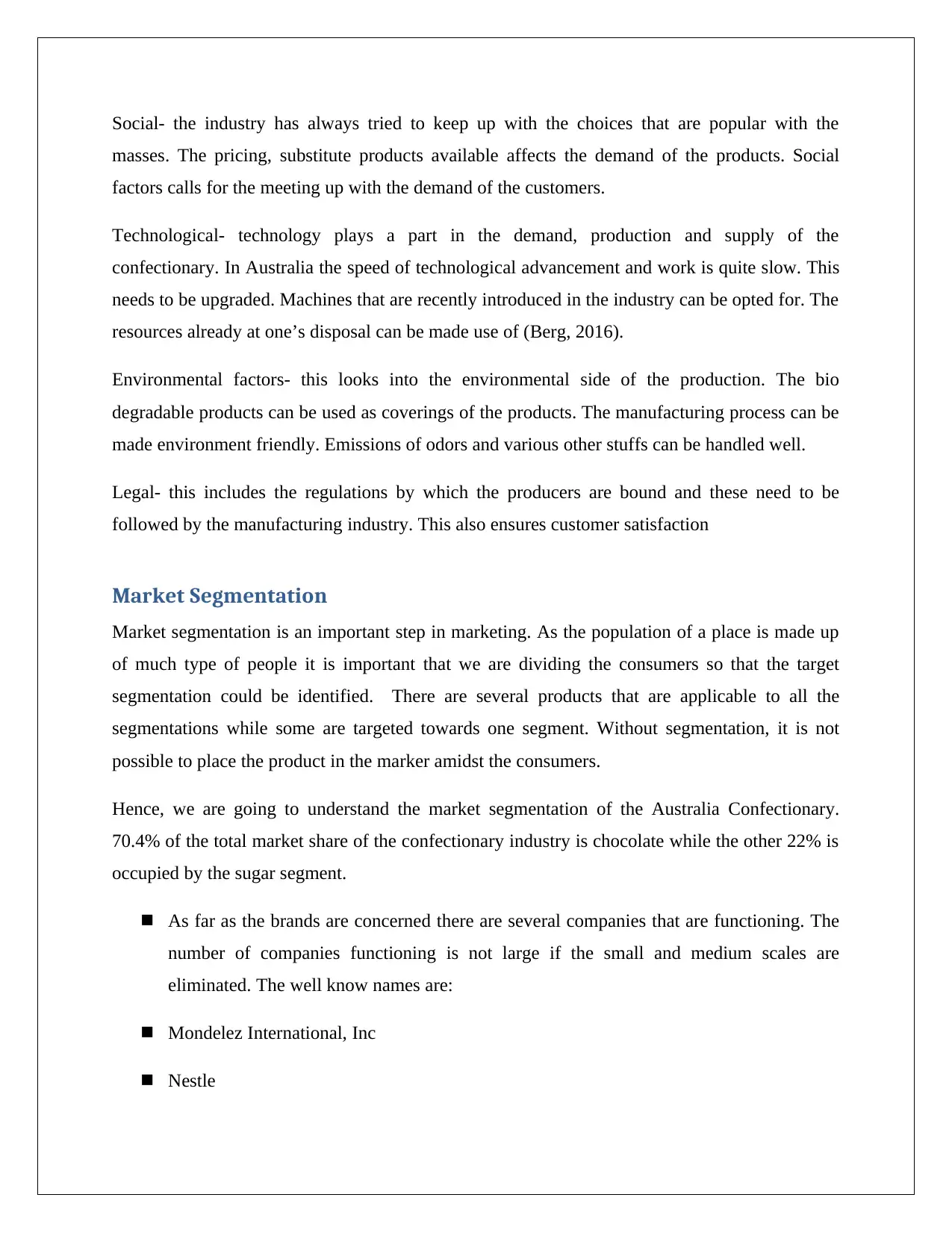
Social- the industry has always tried to keep up with the choices that are popular with the
masses. The pricing, substitute products available affects the demand of the products. Social
factors calls for the meeting up with the demand of the customers.
Technological- technology plays a part in the demand, production and supply of the
confectionary. In Australia the speed of technological advancement and work is quite slow. This
needs to be upgraded. Machines that are recently introduced in the industry can be opted for. The
resources already at one’s disposal can be made use of (Berg, 2016).
Environmental factors- this looks into the environmental side of the production. The bio
degradable products can be used as coverings of the products. The manufacturing process can be
made environment friendly. Emissions of odors and various other stuffs can be handled well.
Legal- this includes the regulations by which the producers are bound and these need to be
followed by the manufacturing industry. This also ensures customer satisfaction
Market Segmentation
Market segmentation is an important step in marketing. As the population of a place is made up
of much type of people it is important that we are dividing the consumers so that the target
segmentation could be identified. There are several products that are applicable to all the
segmentations while some are targeted towards one segment. Without segmentation, it is not
possible to place the product in the marker amidst the consumers.
Hence, we are going to understand the market segmentation of the Australia Confectionary.
70.4% of the total market share of the confectionary industry is chocolate while the other 22% is
occupied by the sugar segment.
As far as the brands are concerned there are several companies that are functioning. The
number of companies functioning is not large if the small and medium scales are
eliminated. The well know names are:
Mondelez International, Inc
Nestle
masses. The pricing, substitute products available affects the demand of the products. Social
factors calls for the meeting up with the demand of the customers.
Technological- technology plays a part in the demand, production and supply of the
confectionary. In Australia the speed of technological advancement and work is quite slow. This
needs to be upgraded. Machines that are recently introduced in the industry can be opted for. The
resources already at one’s disposal can be made use of (Berg, 2016).
Environmental factors- this looks into the environmental side of the production. The bio
degradable products can be used as coverings of the products. The manufacturing process can be
made environment friendly. Emissions of odors and various other stuffs can be handled well.
Legal- this includes the regulations by which the producers are bound and these need to be
followed by the manufacturing industry. This also ensures customer satisfaction
Market Segmentation
Market segmentation is an important step in marketing. As the population of a place is made up
of much type of people it is important that we are dividing the consumers so that the target
segmentation could be identified. There are several products that are applicable to all the
segmentations while some are targeted towards one segment. Without segmentation, it is not
possible to place the product in the marker amidst the consumers.
Hence, we are going to understand the market segmentation of the Australia Confectionary.
70.4% of the total market share of the confectionary industry is chocolate while the other 22% is
occupied by the sugar segment.
As far as the brands are concerned there are several companies that are functioning. The
number of companies functioning is not large if the small and medium scales are
eliminated. The well know names are:
Mondelez International, Inc
Nestle
⊘ This is a preview!⊘
Do you want full access?
Subscribe today to unlock all pages.

Trusted by 1+ million students worldwide
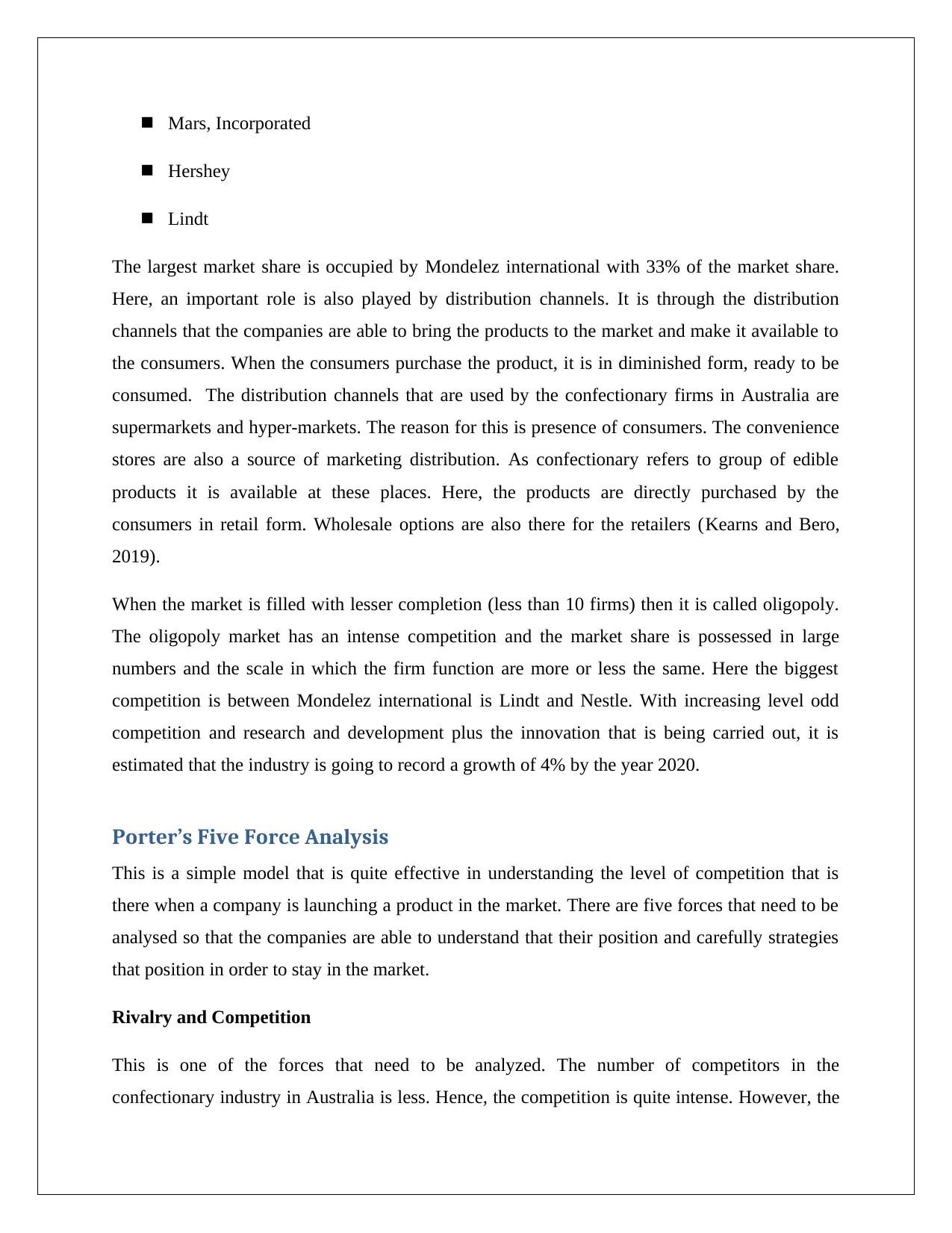
Mars, Incorporated
Hershey
Lindt
The largest market share is occupied by Mondelez international with 33% of the market share.
Here, an important role is also played by distribution channels. It is through the distribution
channels that the companies are able to bring the products to the market and make it available to
the consumers. When the consumers purchase the product, it is in diminished form, ready to be
consumed. The distribution channels that are used by the confectionary firms in Australia are
supermarkets and hyper-markets. The reason for this is presence of consumers. The convenience
stores are also a source of marketing distribution. As confectionary refers to group of edible
products it is available at these places. Here, the products are directly purchased by the
consumers in retail form. Wholesale options are also there for the retailers (Kearns and Bero,
2019).
When the market is filled with lesser completion (less than 10 firms) then it is called oligopoly.
The oligopoly market has an intense competition and the market share is possessed in large
numbers and the scale in which the firm function are more or less the same. Here the biggest
competition is between Mondelez international is Lindt and Nestle. With increasing level odd
competition and research and development plus the innovation that is being carried out, it is
estimated that the industry is going to record a growth of 4% by the year 2020.
Porter’s Five Force Analysis
This is a simple model that is quite effective in understanding the level of competition that is
there when a company is launching a product in the market. There are five forces that need to be
analysed so that the companies are able to understand that their position and carefully strategies
that position in order to stay in the market.
Rivalry and Competition
This is one of the forces that need to be analyzed. The number of competitors in the
confectionary industry in Australia is less. Hence, the competition is quite intense. However, the
Hershey
Lindt
The largest market share is occupied by Mondelez international with 33% of the market share.
Here, an important role is also played by distribution channels. It is through the distribution
channels that the companies are able to bring the products to the market and make it available to
the consumers. When the consumers purchase the product, it is in diminished form, ready to be
consumed. The distribution channels that are used by the confectionary firms in Australia are
supermarkets and hyper-markets. The reason for this is presence of consumers. The convenience
stores are also a source of marketing distribution. As confectionary refers to group of edible
products it is available at these places. Here, the products are directly purchased by the
consumers in retail form. Wholesale options are also there for the retailers (Kearns and Bero,
2019).
When the market is filled with lesser completion (less than 10 firms) then it is called oligopoly.
The oligopoly market has an intense competition and the market share is possessed in large
numbers and the scale in which the firm function are more or less the same. Here the biggest
competition is between Mondelez international is Lindt and Nestle. With increasing level odd
competition and research and development plus the innovation that is being carried out, it is
estimated that the industry is going to record a growth of 4% by the year 2020.
Porter’s Five Force Analysis
This is a simple model that is quite effective in understanding the level of competition that is
there when a company is launching a product in the market. There are five forces that need to be
analysed so that the companies are able to understand that their position and carefully strategies
that position in order to stay in the market.
Rivalry and Competition
This is one of the forces that need to be analyzed. The number of competitors in the
confectionary industry in Australia is less. Hence, the competition is quite intense. However, the
Paraphrase This Document
Need a fresh take? Get an instant paraphrase of this document with our AI Paraphraser
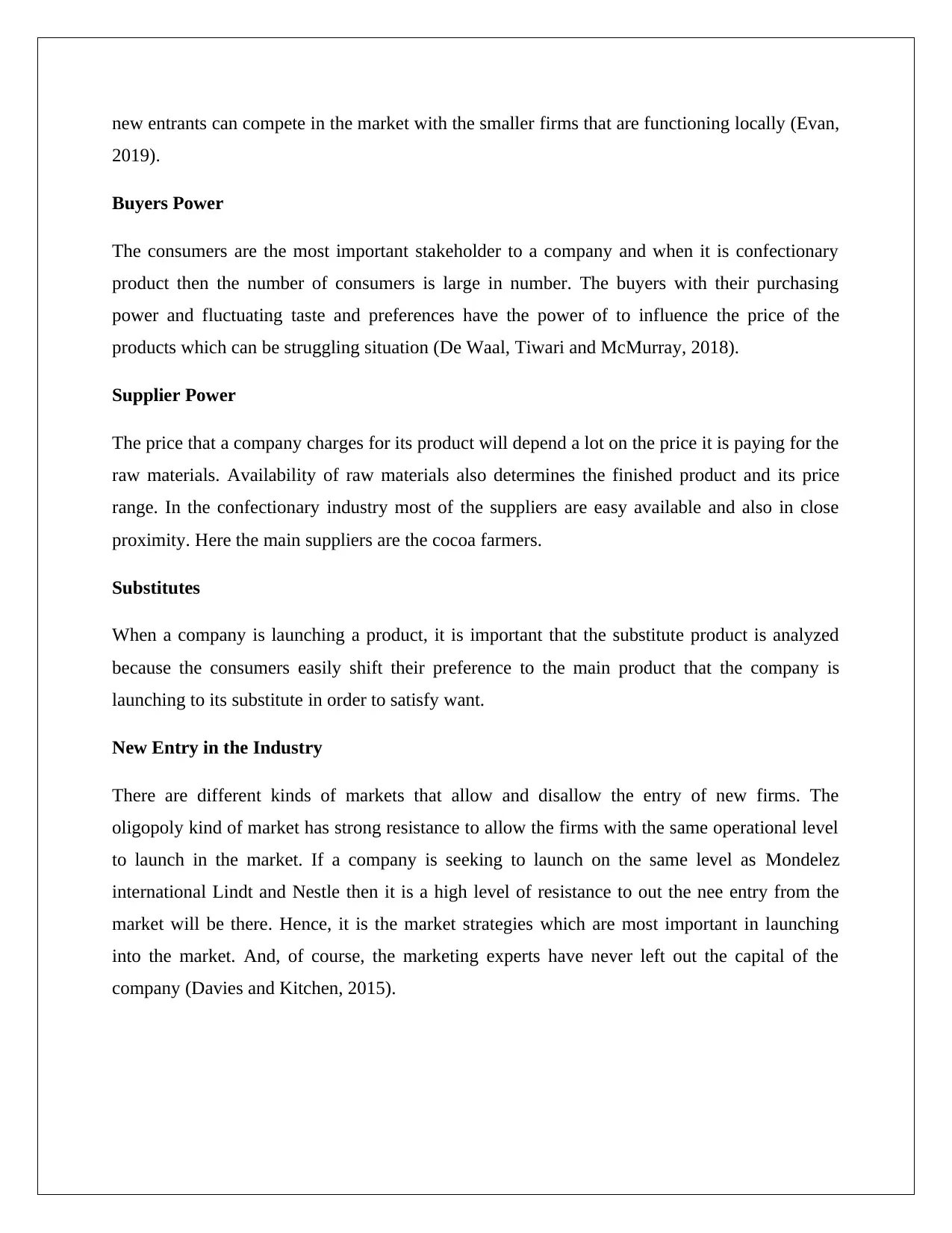
new entrants can compete in the market with the smaller firms that are functioning locally (Evan,
2019).
Buyers Power
The consumers are the most important stakeholder to a company and when it is confectionary
product then the number of consumers is large in number. The buyers with their purchasing
power and fluctuating taste and preferences have the power of to influence the price of the
products which can be struggling situation (De Waal, Tiwari and McMurray, 2018).
Supplier Power
The price that a company charges for its product will depend a lot on the price it is paying for the
raw materials. Availability of raw materials also determines the finished product and its price
range. In the confectionary industry most of the suppliers are easy available and also in close
proximity. Here the main suppliers are the cocoa farmers.
Substitutes
When a company is launching a product, it is important that the substitute product is analyzed
because the consumers easily shift their preference to the main product that the company is
launching to its substitute in order to satisfy want.
New Entry in the Industry
There are different kinds of markets that allow and disallow the entry of new firms. The
oligopoly kind of market has strong resistance to allow the firms with the same operational level
to launch in the market. If a company is seeking to launch on the same level as Mondelez
international Lindt and Nestle then it is a high level of resistance to out the nee entry from the
market will be there. Hence, it is the market strategies which are most important in launching
into the market. And, of course, the marketing experts have never left out the capital of the
company (Davies and Kitchen, 2015).
2019).
Buyers Power
The consumers are the most important stakeholder to a company and when it is confectionary
product then the number of consumers is large in number. The buyers with their purchasing
power and fluctuating taste and preferences have the power of to influence the price of the
products which can be struggling situation (De Waal, Tiwari and McMurray, 2018).
Supplier Power
The price that a company charges for its product will depend a lot on the price it is paying for the
raw materials. Availability of raw materials also determines the finished product and its price
range. In the confectionary industry most of the suppliers are easy available and also in close
proximity. Here the main suppliers are the cocoa farmers.
Substitutes
When a company is launching a product, it is important that the substitute product is analyzed
because the consumers easily shift their preference to the main product that the company is
launching to its substitute in order to satisfy want.
New Entry in the Industry
There are different kinds of markets that allow and disallow the entry of new firms. The
oligopoly kind of market has strong resistance to allow the firms with the same operational level
to launch in the market. If a company is seeking to launch on the same level as Mondelez
international Lindt and Nestle then it is a high level of resistance to out the nee entry from the
market will be there. Hence, it is the market strategies which are most important in launching
into the market. And, of course, the marketing experts have never left out the capital of the
company (Davies and Kitchen, 2015).
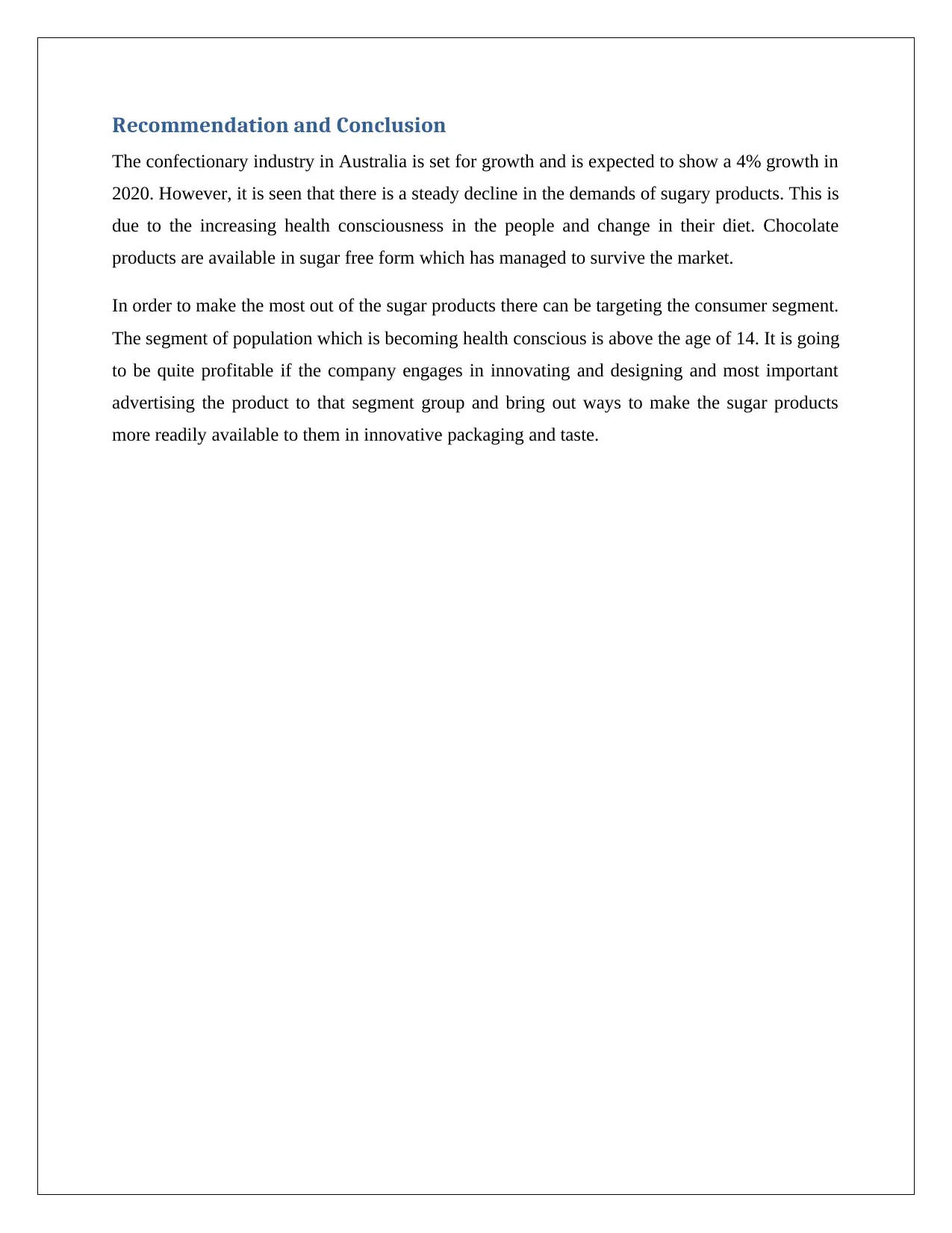
Recommendation and Conclusion
The confectionary industry in Australia is set for growth and is expected to show a 4% growth in
2020. However, it is seen that there is a steady decline in the demands of sugary products. This is
due to the increasing health consciousness in the people and change in their diet. Chocolate
products are available in sugar free form which has managed to survive the market.
In order to make the most out of the sugar products there can be targeting the consumer segment.
The segment of population which is becoming health conscious is above the age of 14. It is going
to be quite profitable if the company engages in innovating and designing and most important
advertising the product to that segment group and bring out ways to make the sugar products
more readily available to them in innovative packaging and taste.
The confectionary industry in Australia is set for growth and is expected to show a 4% growth in
2020. However, it is seen that there is a steady decline in the demands of sugary products. This is
due to the increasing health consciousness in the people and change in their diet. Chocolate
products are available in sugar free form which has managed to survive the market.
In order to make the most out of the sugar products there can be targeting the consumer segment.
The segment of population which is becoming health conscious is above the age of 14. It is going
to be quite profitable if the company engages in innovating and designing and most important
advertising the product to that segment group and bring out ways to make the sugar products
more readily available to them in innovative packaging and taste.
⊘ This is a preview!⊘
Do you want full access?
Subscribe today to unlock all pages.

Trusted by 1+ million students worldwide
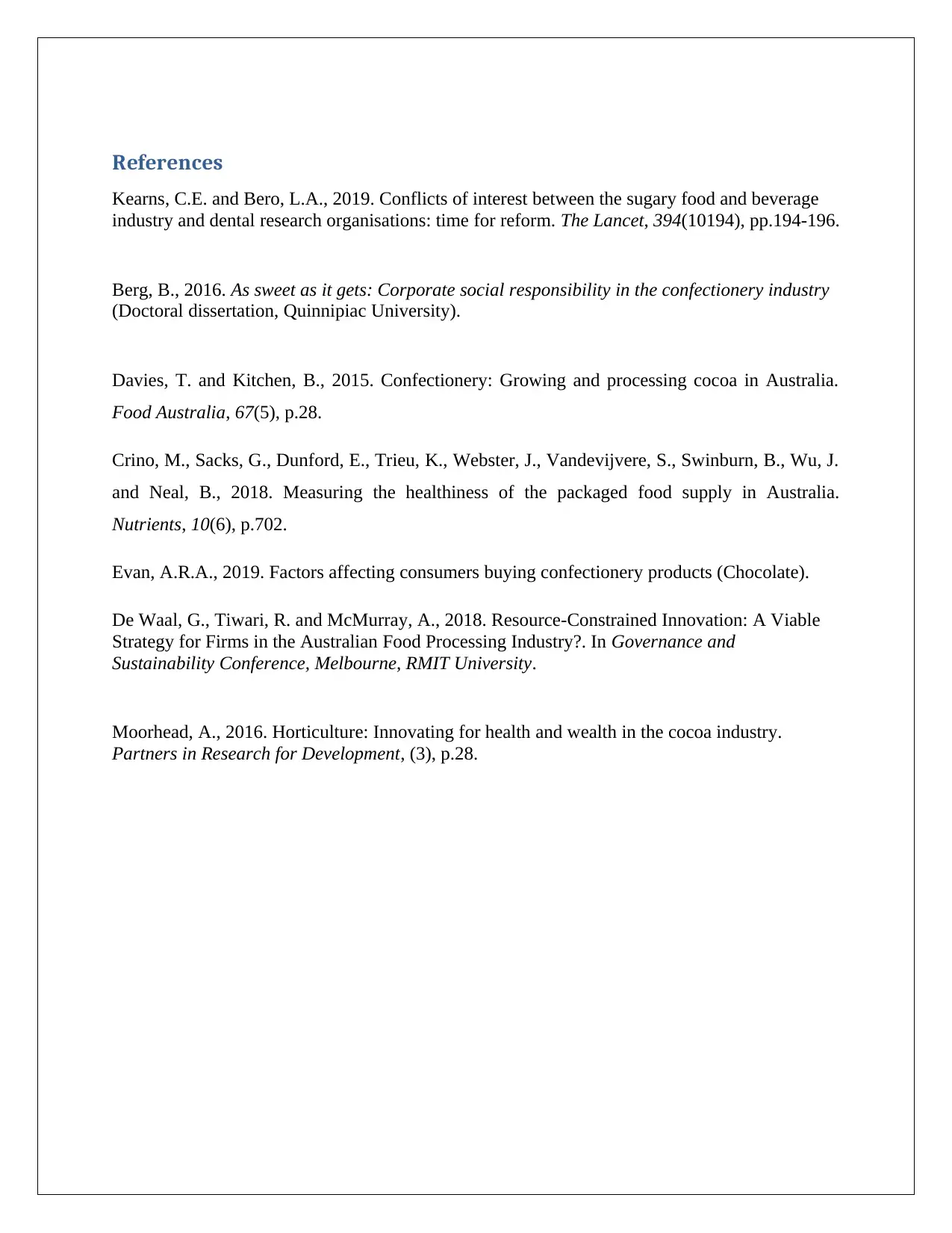
References
Kearns, C.E. and Bero, L.A., 2019. Conflicts of interest between the sugary food and beverage
industry and dental research organisations: time for reform. The Lancet, 394(10194), pp.194-196.
Berg, B., 2016. As sweet as it gets: Corporate social responsibility in the confectionery industry
(Doctoral dissertation, Quinnipiac University).
Davies, T. and Kitchen, B., 2015. Confectionery: Growing and processing cocoa in Australia.
Food Australia, 67(5), p.28.
Crino, M., Sacks, G., Dunford, E., Trieu, K., Webster, J., Vandevijvere, S., Swinburn, B., Wu, J.
and Neal, B., 2018. Measuring the healthiness of the packaged food supply in Australia.
Nutrients, 10(6), p.702.
Evan, A.R.A., 2019. Factors affecting consumers buying confectionery products (Chocolate).
De Waal, G., Tiwari, R. and McMurray, A., 2018. Resource-Constrained Innovation: A Viable
Strategy for Firms in the Australian Food Processing Industry?. In Governance and
Sustainability Conference, Melbourne, RMIT University.
Moorhead, A., 2016. Horticulture: Innovating for health and wealth in the cocoa industry.
Partners in Research for Development, (3), p.28.
Kearns, C.E. and Bero, L.A., 2019. Conflicts of interest between the sugary food and beverage
industry and dental research organisations: time for reform. The Lancet, 394(10194), pp.194-196.
Berg, B., 2016. As sweet as it gets: Corporate social responsibility in the confectionery industry
(Doctoral dissertation, Quinnipiac University).
Davies, T. and Kitchen, B., 2015. Confectionery: Growing and processing cocoa in Australia.
Food Australia, 67(5), p.28.
Crino, M., Sacks, G., Dunford, E., Trieu, K., Webster, J., Vandevijvere, S., Swinburn, B., Wu, J.
and Neal, B., 2018. Measuring the healthiness of the packaged food supply in Australia.
Nutrients, 10(6), p.702.
Evan, A.R.A., 2019. Factors affecting consumers buying confectionery products (Chocolate).
De Waal, G., Tiwari, R. and McMurray, A., 2018. Resource-Constrained Innovation: A Viable
Strategy for Firms in the Australian Food Processing Industry?. In Governance and
Sustainability Conference, Melbourne, RMIT University.
Moorhead, A., 2016. Horticulture: Innovating for health and wealth in the cocoa industry.
Partners in Research for Development, (3), p.28.
1 out of 7
Related Documents
Your All-in-One AI-Powered Toolkit for Academic Success.
+13062052269
info@desklib.com
Available 24*7 on WhatsApp / Email
![[object Object]](/_next/static/media/star-bottom.7253800d.svg)
Unlock your academic potential
Copyright © 2020–2025 A2Z Services. All Rights Reserved. Developed and managed by ZUCOL.





